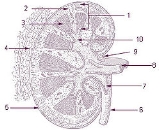
Renal medulla
Overview
Kidney
The kidneys, organs with several functions, serve essential regulatory roles in most animals, including vertebrates and some invertebrates. They are essential in the urinary system and also serve homeostatic functions such as the regulation of electrolytes, maintenance of acid–base balance, and...
. The renal medulla is split up into a number of sections, known as the renal pyramids
Renal pyramids
Renal pyramids are cone-shaped tissues of the kidney. The renal medulla is made up of 7 to 18 of these conical subdivisions . The broad base of each pyramid faces the renal cortex, and its apex, or papilla, points internally...
. Blood enters into the kidney via the renal artery, which then splits up to form the arcuate arterioles. The arcuate arterioles each in turn branch into interlobular arterioles, which finally reach the glomeruli. At the glomerulus the blood reaches a highly disfavourable pressure gradient and a large exchange surface area, which forces the serum
Serous fluid
In physiology, the term serous fluid is used for various bodily fluids that are typically pale yellow and transparent, and of a benign nature, that fill the inside of body cavities. Serous fluid originates from serous glands, with secretions enriched with proteins and water. Serous fluid may also...
portion of the blood out of the vessel into the renal tubules.

